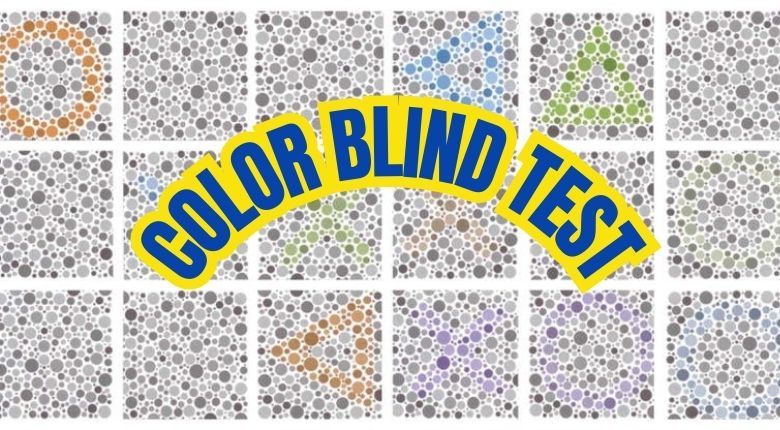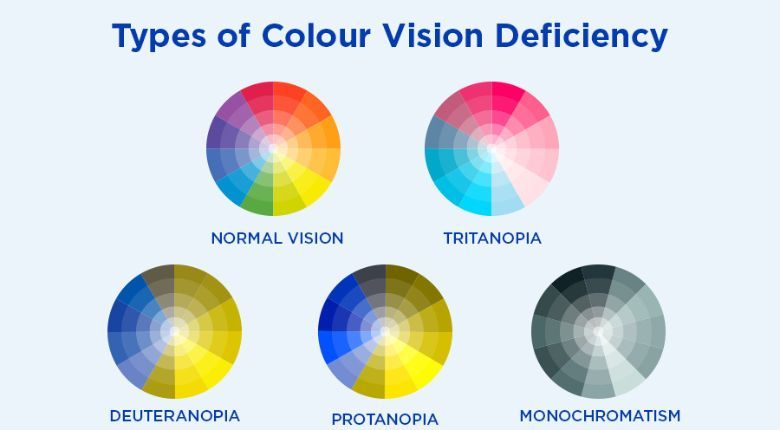About
Color Blind Test: Importance, How it Works, and Results

A color Blind test examines a person’s ability to see colours to determine if they have any color deficiencies, typically performed by an optometrist as part of an eye test. Types of color Blind tests include an Ishihara test (color plate test) and a colour hue test ( color arrangement test).
The types of color Blind deficiency, colloquially known as colour blindness, a Color Blind Test can diagnose include red-green colour vision deficiency, blue-yellow color Blind deficiency and monochromatism.
Color Blind deficiency is most often caused by genetics but can also be due to certain diseases, injuries, medications and chemicals. Keep reading to learn more about how color Blind tests work and what their results reveal about a person’s ability to see color.
What Is A Color Blind Test?
A Color Blind Test is performed by an eye care professional to examine a person’s colour vision for any deficiencies. A color Blind test will involve a patient identifying or sorting colors to determine what colors they can see and those that they cannot.
The most common type of Color Blind Test, according to the National Eye Institute, is an Ishihara test, also known as a color plate test. An Ishihara test consists of circles or plates made up of dots of a certain color in varying shades, with a number in the middle made out of the same dots but in a different color.
If a person is unable to see the number in the middle of an Ishihara test, then they may have color vision deficiency as their eyes have not differentiated between the two colours on the plate. Another type of Color Blind Test is a color hue test. A color hue test determines if a person has color vision deficiency using blocks of varying colors.
The aim of the test is for the patient to order the blocks, often in rainbow order. If the blocks are not in the specified order, it can indicate a type of colour vision deficiency.
What Is The Importance Of A Color Blind Test?
A Color Blind Test is very important as it can diagnose a person who has colour vision deficiency or colour blindness. Colour vision deficiency, colloquially known as colour blindness, is a condition where a person has difficulty seeing colours in a normal way.
According to Health Direct, color vision deficiency may make people confuse colours, or make some colours appear less bright. A color Blind test is most often performed as part of an eye test by an optometrist using a colour hue test or an Ishihara test.
How Does A Color Blind Test Work?
A Color Blind Test works by determining the colours a person can see using different tests. According to the National Eye Institute, a colour plate test, also known as an Ishihara test, is most commonly used and works by using different coloured dots in a circle typically with a number in the middle which the patient is asked to identify. For people who have deficits in their colour vision, the number may blend into the background colour and therefore they cannot see it.
If the results of a color plate test are inconclusive, the eye care professional may ask the patient to do a color hue test. A color hue test, also known as a colour arrangement test, requires a patient to arrange colored blocks in rainbow order. A color hue test may be used for people who need accurate color vision for their jobs such as graphic designers, according to the National Eye Institute.
What Does A Color Blind Test Diagnose?
A Color Blind Test will diagnose color Blind deficiency, an eye condition in which the eyes have trouble seeing colour properly. There are three main types of color vision deficiency which are red-green color vision deficiency, blue-yellow color vision deficiency and monochromatism. The types of color vision deficiencies and their definitions are listed below.
Red-green color Blind deficiency: Red-green color Blind deficiency has four categories which include protanomaly, deuteranomaly, protanopia and deuteranopia.
Blue-yellow color Blind deficiency: Blue-yellow colour Blind deficiency includes two categories which are tritanopia and tritanomaly.
Monochromatism: Monochromatism, also known as complete color blindness, occurs when a person cannot see any colour.

1. Red-green Color Blind Deficiency
Red-green color Blind deficiency can be categorised into four types, protanomaly, deuteranomaly, protanopia and deuteranopia. Protanomaly is a mild form of red-green colour vision deficiency that can make the appearance of red colours look more green and darkened.
Deuteranomaly is the most common type of red-green color Blind deficiency that results in green colours appearing red. Protanopia can occur as a result of absent L cones and can cause the inability of the eyes to see red colours. Deuteranopia can develop due to missing M cones and can hinder the eyes from seeing green colours.
2. Blue-yellow Color Blind Deficiency
Blue-yellow colour Blind deficiency, also known as anomalous trichromacy is categorised into two types, tritanopia and tritanomaly. Tritanopia is a rare type of blue-yellow colour vision deficiency that makes it difficult for a person to differentiate between blue and green, purple and red and yellow and pink.
Tritanomaly Strong Text is the other type of blue-yellow color Blind deficiency that occurs when the S cones of the eye are present but are not functioning properly. This may cause the inability to distinguish between red and yellow and between blue and green.
3. Monochromatism
Monochromatism is known as complete colour blindness and prevents the eyes from perceiving colors. Due to the lack of working cone photoreceptors, people with this type of color deficiency may only be capable of seeing grey colours, according to the National Library of Medicine.
People with monochromatism may also be susceptible to other vision problems such as low visual acuity and nystagmus. Monochromatism is considered the most rare and severe type of color Blind deficiency and cannot be treated. It is generally caused by genetic defects and can appear during infancy.
What Are The Causes Of Poor Color Blind?
The most common cause of poor color Blind, or color Blind deficiency, is genetics, meaning a person is born with the condition that has been passed down from their parents. Other causes of color Blind deficiency, according to the Mayo Clinic include diseases, injury, medications and chemicals. These causes of poor color vision and their definitions are listed below.
Genetics: Genetics is the most common cause of color vision deficiency meaning the issue is passed down from parent to child. According to the National Eye Institute, this occurs through genes on chromosomes, which are made of DNA.
Diseases: Certain diseases such as diabetes, Alzheimer’s disease, leukaemia, glaucoma, Parkinson’s disease, sickle cell anaemia and macular degeneration can cause colour deficits.
Injuries: Color Blind deficiency can be caused by injuries to the optic nerve, retina and even the brain. These injuries include retinal detachment and eye injuries caused by lasers.
Medications: Some medications are known to alter a person’s color vision. These medications include those used to treat heart problems, autoimmune diseases, infections and high blood pressure.
Chemicals: If a person is exposed to specific chemicals, it may cause color vision deficiency. According to the Mayo Clinic, these chemicals can include those found in certain workplaces such as fertilisers and carbon disulfide.
Does Damage to the Optic Nerve Cause Poor Color Blind?
Yes, damage to the optic nerve can cause poor color vision. The optic nerve is involved in color vision as, according to the American Optometric Association, pigments inside the light-sensitive cones in the eye register different colors and send this information through the optic nerve to the brain.
Glaucoma is an eye condition that can cause damage to the optic nerve due to increased eye pressure. This pressure negatively affects the optic nerve and may lead to loss of colour recognition.
How to Prepare for a Color Blind Test?
There is no preparation needed for a color vision test.
What Happens During a Color Blind Test?
What happens during a Color Blind Test will be determined by the type of test being performed by the eye care professional. While each test will assess a person’s color vision, they are different in their approaches as a color hue test uses blocks whereas an Ishihara test uses color plates.
What Happens After a Color Blind Test?
After a Color Blind Test, your optometrist will go through your results and determine if you have any color Blind deficiencies. If the results are inconclusive, they may perform other color Blind tests. According to the National Eye Institute, in many cases, a color Blind deficiency diagnosis is not very serious as most people with this condition do not experience problems with everyday activities.
How Accurate is a Color Blind Test?
A Color Blind Test is recognised as fairly accurate although it can depend on certain variables such as the accuracy of the patient’s answers. According to the National Eye Institute, it can be difficult to diagnose color Blind deficiency in children as they may try to hide it. Also, in the case of an Ishihara test, accuracy can be determined by how many colour plates a patient is tested on.
Are There Risks in a Color Blind Test?
There are no risks in a Color Blind Test. The two main types of Color Blind Test, a color hue test and an Ishihara test, are non-invasive. A color hue test involves a patient arranging blocks of different colours and an Ishihara test uses plates made up of different colored dots and requires the patient to identify numbers within the dots.
What is the Relation of Color Blind Test to Color Blindness?
A Color Blind Test is a way to determine if a person has color blindness, or more accurately, any type of color Blind deficiency. There are three types of color vision deficiency, monochromatism, which is complete colour blindness, blue-yellow color blindness and red-green color blindness. The types of tests used to assess color Blind include an Ishihara color test and a colour hue test.
What is the Difference Between a Colour Vision Test and a Colour Blind Test?
There is no difference between a color Blind test and a color blind test, they are simply different terms to refer to the same types of tests. A color vision test is performed to measure a person’s color vision against a standard of color Blind to determine if they have any deficiencies.
Color blindness is the colloquial term for color Blind deficiency and can be tested using an Ishihara color blindness test or color hue test.
Who Performs a Color Blind Test?
The eye care professional who performs a color Blind test is most commonly an optometrist. An optometrist is a healthcare professional who provides fundamental eye care services such as eye tests and prescriptions. An optometrist can perform a color Blind test as part of an eye test appointment.
Does Oscar Wylee Offer a Color Blind Test?
Yes, Oscar Wylee offers a color vision test for patients who require it. While it is not part of a standard eye test, if a patient is having issues or concerns with their color vision, they should let the optometrist know and they will take the appropriate course to test their vision. You can book an Oscar Wylee eye test online or in-store.
What are the Eye Exam Locations Near Me?
There are many eye exam locations you can find if you need to have your color vision tested or just for a regular eye test appointment with an optometrist. If you’re looking for an eye exam location near me, you can choose one of Oscar Wylee’s many stores across Australia.
We have stores in the Australian Capital Territory, New South Wales, the Northern Territory, Queensland, South Australia, Tasmania, Victoria and Western Australia.